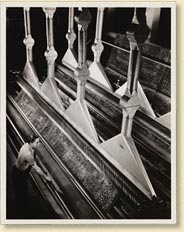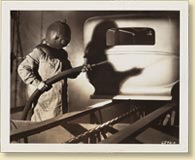The Medium: Industrial Photography and the
Machine Age
Any great art which might be developed in this industrial age will come from industrial subjects, which are so powerful . . . and art, to be of any importance as a reflection of these times, must hold the germ of that power.Margaret Bourke-White, 1930
 A number of early scientific management studies had relied on photography as a source of objective data, including the seminal analyses of worker movements found in compelling images by Eadweard Muybridge in the 1880s and by Frank and Lillian Gilbreth in the early 1900s. For Harvard students, Ayres was particularly interested in documentary records that illustrated action and labor-saving devices. For all their faithful rendering of detail, however, the publicity images donated by businesses depicted workers and machines within the conventions of a highly refined art form. From the simple expository illustrations of early industrial photography, the genre had evolved by the 1930s into a stylized medium of iconic imagery that celebrated America’s industrial might.
A number of early scientific management studies had relied on photography as a source of objective data, including the seminal analyses of worker movements found in compelling images by Eadweard Muybridge in the 1880s and by Frank and Lillian Gilbreth in the early 1900s. For Harvard students, Ayres was particularly interested in documentary records that illustrated action and labor-saving devices. For all their faithful rendering of detail, however, the publicity images donated by businesses depicted workers and machines within the conventions of a highly refined art form. From the simple expository illustrations of early industrial photography, the genre had evolved by the 1930s into a stylized medium of iconic imagery that celebrated America’s industrial might.
 Machine Age photography, influenced by the Cubist movement, was expressed in the work of Margaret Bourke-White, Russell Aikins, William Rittase, many lesser known photographers, and countless anonymous practitioners whose work students would find in the industrial photograph collection. Experimenting with light, composition, and composite photography, Machine Age photographers created elemental shapes and abstractions of industrial production that extolled the functional beauty of worker and machine. In an image produced for the Bigelow-Sanford Carpet Company, for example, the imposing arms of a loom form a powerful geometric pattern against the employee, who feeds the massive machine, while a publicity shot for the Packard Motor Company reveals a striking shadow behind the futurist form of the worker blasting paint.
Machine Age photography, influenced by the Cubist movement, was expressed in the work of Margaret Bourke-White, Russell Aikins, William Rittase, many lesser known photographers, and countless anonymous practitioners whose work students would find in the industrial photograph collection. Experimenting with light, composition, and composite photography, Machine Age photographers created elemental shapes and abstractions of industrial production that extolled the functional beauty of worker and machine. In an image produced for the Bigelow-Sanford Carpet Company, for example, the imposing arms of a loom form a powerful geometric pattern against the employee, who feeds the massive machine, while a publicity shot for the Packard Motor Company reveals a striking shadow behind the futurist form of the worker blasting paint.
- Baker Library | Historical Collections | Site Credits | Digital Accessibility
- Contact Email: histcollref@hbs.edu
